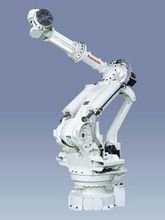Industrial robots are multi-joint robots or multi-degree-of-freedom machines for industrial applications.

It can perform work automatically, and it is a kind of machine that realizes various functions by its own power and control ability.
It can be commanded by humans or run in a pre-programmed program.
Modern industrial robots can also act according to the principles outlined in artificial intelligence technology.
The composition of the structure
Industrial robots consist of three basic parts: the main body, the drive system and the control system.
The main body is the base and the actuator, including the arm, the wrist and the hand, and some robots and walking mechanisms.
Most industrial robots have 3 to 6 degrees of freedom of movement, of which the wrist usually has 1 to 3 degrees of freedom of movement;
The drive system includes a power unit and a transmission mechanism for causing the actuator to generate a corresponding action;
The control system issues and controls the drive system and the actuator according to the input program.
Industrial robots are divided into four types according to the movement of the arms.
The Cartesian arm can be moved along three orthogonal coordinates;
The drive system includes a power unit and a transmission mechanism for causing the actuator to generate a corresponding action;
The control system issues and controls the drive system and the actuator according to the input program.
Industrial robots are divided into four types according to the movement of the arms.
The Cartesian arm can be moved along three orthogonal coordinates;
The cylindrical coordinate type arm can be used for lifting, turning and telescopic movement;
The spherical coordinate type of the arm can be rotated, pitched and telescoped;
The articulated arm has a plurality of rotating joints.
The industrial robot is controlled by the movement of the actuator, and can be divided into a point type and a continuous track type.
The point type only controls the accurate positioning of the actuator from one point to another, and is suitable for machine loading and unloading, spot welding and general handling, loading and unloading operations;
The continuous track type controls the actuator to move according to a given trajectory and is suitable for continuous welding and painting.
Industrial robots are classified into two types: programming input type and teaching input type.
The programming input type is to transfer the programmed program files on the computer to the robot control cabinet through RS232 serial port or Ethernet communication.
There are two teaching methods for teaching input type:
One is that the operator uses a manual controller (teaching operation box) to transmit the command signal to the drive system, so that the actuator can perform the operation according to the required action sequence and motion trajectory;
The other is that the operator directly leads the actuator and performs it according to the required sequence of motions and motion trajectories.
At the same time as the teaching process, the information of the working program is automatically stored in the program memory. When the robot automatically works, the control system detects the corresponding information from the program memory, and transmits the command signal to the drive mechanism, so that the actuator can reproduce the teaching. Various actions.
The industrial robot that teaches the input program is called a teaching and reproducing industrial robot.
Industrial robots with tactile, forceful or simple vision that can work in more complex environments;
If it has an identification function or further increases the adaptive, self-learning function, it becomes an intelligent industrial robot.
It can adapt to the environment according to the “macro” selection or self-programming given by people, and automatically complete more complicated work.
The technical principle
The robot control system is the brain of the robot and is the main factor determining the function and performance of the robot.
The main task of industrial robot control technology is to control the position, attitude and trajectory of industrial robots in the workspace, the sequence of operations and the time of action.
It has the characteristics of simple programming, software menu operation, friendly human-computer interaction interface, online operation prompts and easy to use.
Key technologies include:
(1) Open modular control system architecture: a distributed CPU computer architecture.
It is divided into robot controller (RC), motion controller (MC), photoelectric isolation I/O control board, sensor processing board and programming teaching box.
The robot controller (RC) and the programming teach pendant communicate via the serial/CAN bus.
The main computer of the robot controller (RC) completes the motion planning, interpolation and position servo of the robot as well as the main control logic, digital I/O, sensor processing and other functions.
The programming teaching box completes the display of information and the input of keys.
(2) Modular hierarchical controller software system
The software system is built on the open source-based real-time multitasking operating system Linux, which adopts layered and modular structure design to realize the openness of the software system.
The entire controller software system is divided into three levels: hardware driver layer, core layer and application layer.
The three levels face different functional requirements and correspond to different levels of development.
Each level in the system consists of several modules with opposite functions.
These functional modules work together to implement the functionality provided by this level.
(3) Robot fault diagnosis and safety maintenance technology
Diagnosing robot faults and performing corresponding maintenance through various information is the key technology to ensure the safety of the robot.
(4) Networked robot controller technology
The application engineering of current robots has evolved from a single robotic workstation to a robotic production line, and the networking technology of robot controllers has become increasingly important.
The controller has networking functions of serial port, field bus and Ethernet.
It can be used for communication between robot controllers and robot controllers with the host computer, which is convenient for monitoring, diagnosis and management of the robot production line.
Copyright © Jiangsu Hoston Machine Tools Co., Ltd. (Hongkong Hoston Group CO., LIMITED)All Rights Reserved | Sitemap Technical Support: 